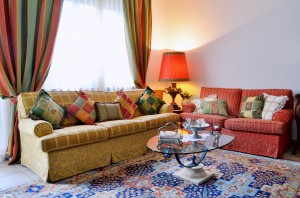 Each and every interior design project has a budget, and that budget has absolutely nothing to do with money.
Each and every interior design project has a budget, and that budget has absolutely nothing to do with money.
A harmonious space is a careful allocation of color, scale, proportion, balance, pattern and texture. The successful path to a well decorated room spends the “budget” thoughtfully.
The quickest route to a DIY decorating disaster is to consider each element independently of the others. When making any selection, treat it as an allocation and ask yourself whether that is really where you want to spend your budget for that piece of the puzzle.
The easiest part of the “budget” to blow is pattern.
Consider a scenario where patterned flooring is selected before the other elements. Suddenly, patterns in textiles for furnishings are severely limited. This is fine if the flooring is going to be the focal point, such as with a fabulous area rug. It is a waste of budget if it is just an arbitrary selection and not the component that will make the room fabulous.
Pattern can be used in abundance or sparingly, but it spends the budget the same. It sets the mood for the entire space and leads the way hand in hand with color.
Color has a definite impact on the mood that you want to create. Crisp, bold colors tend to be more modern while muted, subtle tones create a more traditional atmosphere.
Texture is the backdrop for pattern and color. It provides subtle interest and can be repeated without drawing from the pattern.
In addition, the following elements are a part of the design budget:
Scale and proportion are two design principles that go hand in hand, since both relate to size and shape. Proportion has to do with the ratio of one design element to another, while scale concerns itself with the size of one object as compared to another.
Rhythm is the repetition of shapes, color, pattern and texture.
Balance can be symmetrical (identical items repeated on each side of a focal point), asymmetrical (less contrived but balanced based on visual weight and scale), or radial (elements are placed around a center point).
Think carefully about how to use your allowance when decorating and consider whether an element is really worth the” investment.” After all, your budget is limited.


